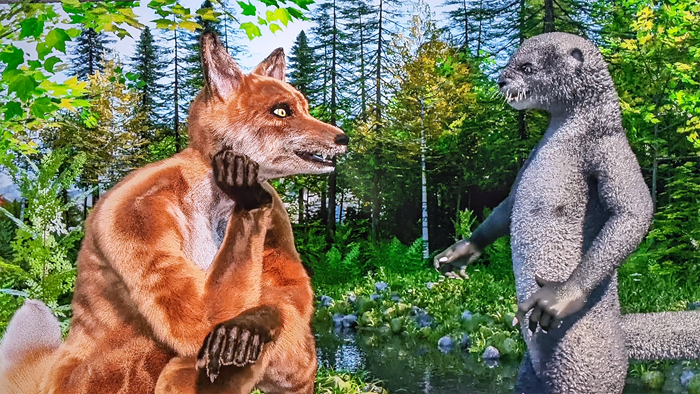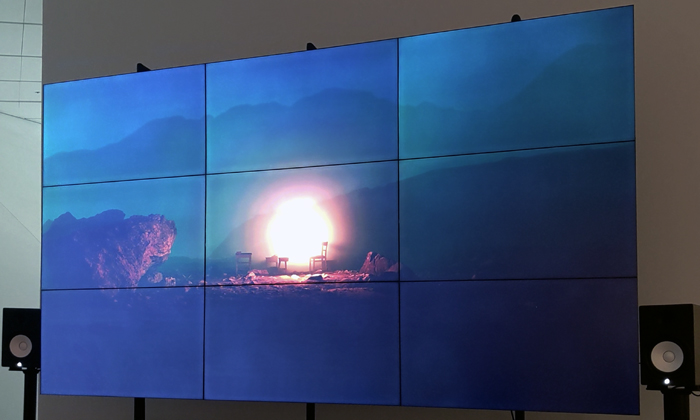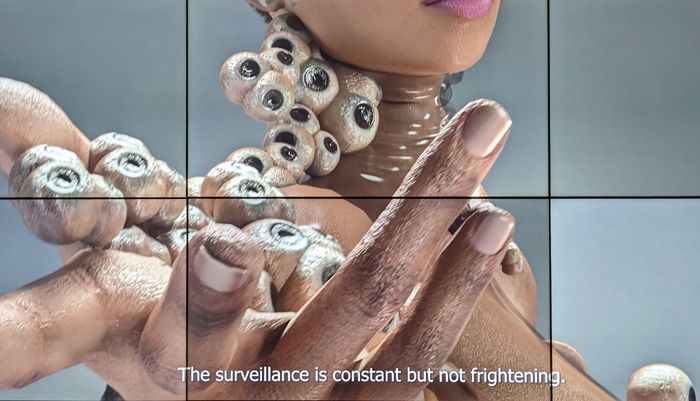In Denver Art Museum’s Who Tells a Tale Adds a Tail, Latin American millennial artists transform narratives rooted in collective memory and the virtual realm of cyberspace.

Who Tells a Tale Adds a Tail: Latin America and Contemporary Art
July 31, 2022–March 5, 2023
Denver Art Museum
The genre of contemporary Latin American art doesn’t necessarily conjure a cohesive aesthetic, and that’s precisely the point in the Denver Art Museum exhibition Who Tells a Tale Adds a Tail: Latin America and Contemporary Art. However, by focusing on artists born between 1982 and 1996, the exhibition reveals common themes inherent to digital nativity, specifically in relation to legacies of colonialism, civil unrest, and notions of identity across the Americas.
The first exhibition organized by Raphael Fonseca, the DAM’s recently appointed associate curator of modern and contemporary Latin American art, Who Tells a Tale Adds a Tail is a mesmerizing group show featuring nineteen millennial artists whose technology-infused works invoke dreams, nightmares, generational trauma, and permutations of resistance.
The exhibition’s title refers to an aphorism from the curator’s native Brazil, “Quem conta um conto, aumenta um ponto.” This proverb suggests that all stories are fluid rather than fixed—evolving, shifting, and propelled forth by their narrators. The show includes artists from Argentina, Bolivia, Brazil, Chile, Colombia, Ecuador, Guatemala, and Mexico, unique nations with complex histories, all of which have suffered under colonial rule.

Fonseca’s curation expertly navigates cross-currents of political violence and forced migration, ritualized performance, gender and cultural identity, and sexual freedom. According to Fonseca, “The exhibition explores questions of what it means to inhabit identities such as Latin American, Latinx, Indigenous or Native, or queer within the context of present-day phenomena like global hegemony, pandemics, climate change, and assault on human and civil rights.”
Among the most powerful works on view is Claudia Martínez Garay’s speculative video and quadratic sound installation Ayataki, which channels the grief and isolation incited by the Peruvian civil war. Dystopian to its core, the work is both eerily beautiful and profoundly sad. Traditional hymns of the Peruvian Andes and audio recordings of survivors from the 1980s conflict underscore computer-generated scenes of abandoned and battle-scorched vistas, stairways to nowhere, and a shimmering radio tower—a monolith symbol of the military-industrial complex.
In one scene, the starry sky—resplendent and peaceful—is shown sandwiched between two earth forms, as if seen from the bottom of a ditch (or open grave). This point of view creates a visceral empathy for the hunted—those families forced to flee their homes and seek safety underground. The ditch, however, is suddenly illuminated by menacing searchlights, quickly mutating from a source of comfort to a perilous threat, invoking captivity with nowhere to hide.

Vitória Cribb, a twenty-five-year-old Brazilian Haitian digital artist and Afrofuturist, approaches the notion of surveillance through virtual avatars. Her animated video VIGILANTE_EXTENDED depicts a series of deities, the “Vigilantes,” covered in glistening eyeballs and enlarged ears, but who nevertheless recall the algorithmic beauty of surgically-enhanced Instagram influencers. These are the invisible watchers monitoring all online activity, a manifestation of the myriad anxieties that accumulate in the wake of social media and which have the power to either reinforce—or totally obliterate—one’s sense of self in the digital era.
For much of the world, self-identity in relation to gender is inexorably tangled with linguistics. When a language is gendered, such as Spanish and Portuguese (and many others), carving out space for the non-binary is an existential imperative, both literally and figuratively. Artist Seba Calfuqueo addresses this cognitive dissonance and the machismo of their Indigenous Mapuche and Chilean cultures in a delightfully bizarre three-dimensional video featuring an otter and a gender-fluid fox titled Ngürü Ka Williñ.
What appears to be an updated children’s fable takes an unexpected and comically erotic turn that subverts traditional gender roles vis-à-vis sexual orientation. In a video interview produced by the DAM, Calfuqueo states that “Indigenous artists are deprived of thinking in technology,” a reference to the digital colonialism already entrenched in the code of cyberspace. Through their work, Calfuqueo aims to “corrupt” the patriarchal paradigms, cultural heritage, and “macho” narratives bound to binary thought.

The absurdity of Calfuqueo’s animation is ratcheted up a few notches in Randolpho Lamonier and Victor Galvão’s video montage, appropriately titled Sunset Fever. Shown within a mixed-media installation by Lamonier that includes everyday items arranged in totemic grandeur, Sunset Fever is a sardonic deluge of digital imagery, ever-accelerating and threatening total sensory overload. With nods to Brazil’s urban landscape, with its gang violence, poverty, desire, and excess, the work critiques our shared human condition as cybernetic beings—hyper-connected but rarely fulfilled.
To Fonseca’s curatorial credit, all of the works featured in Who Tells a Tale Adds a Tail have ample breathing room across the DAM’s fourth floor, with its jagged architecture and angular spaces. As a cohesive statement, the show feels both heavy and light, its singular voices melding together in poetic polyphony, forging onwards and composing new narratives as they go. For his first exhibition at the DAM, Fonseca—and the millennial artists on view—have set the bar exceptionally high and proven that digital world-building can provide a safe haven for cultural reflection, self-actualization, and even joy IRL.
Who Tells a Tale Adds a Tail: Latin America and Contemporary Art is scheduled to continue through March 5, 2023 at the Denver Art Museum, 100 West 14th Avenue Parkway in Denver.




